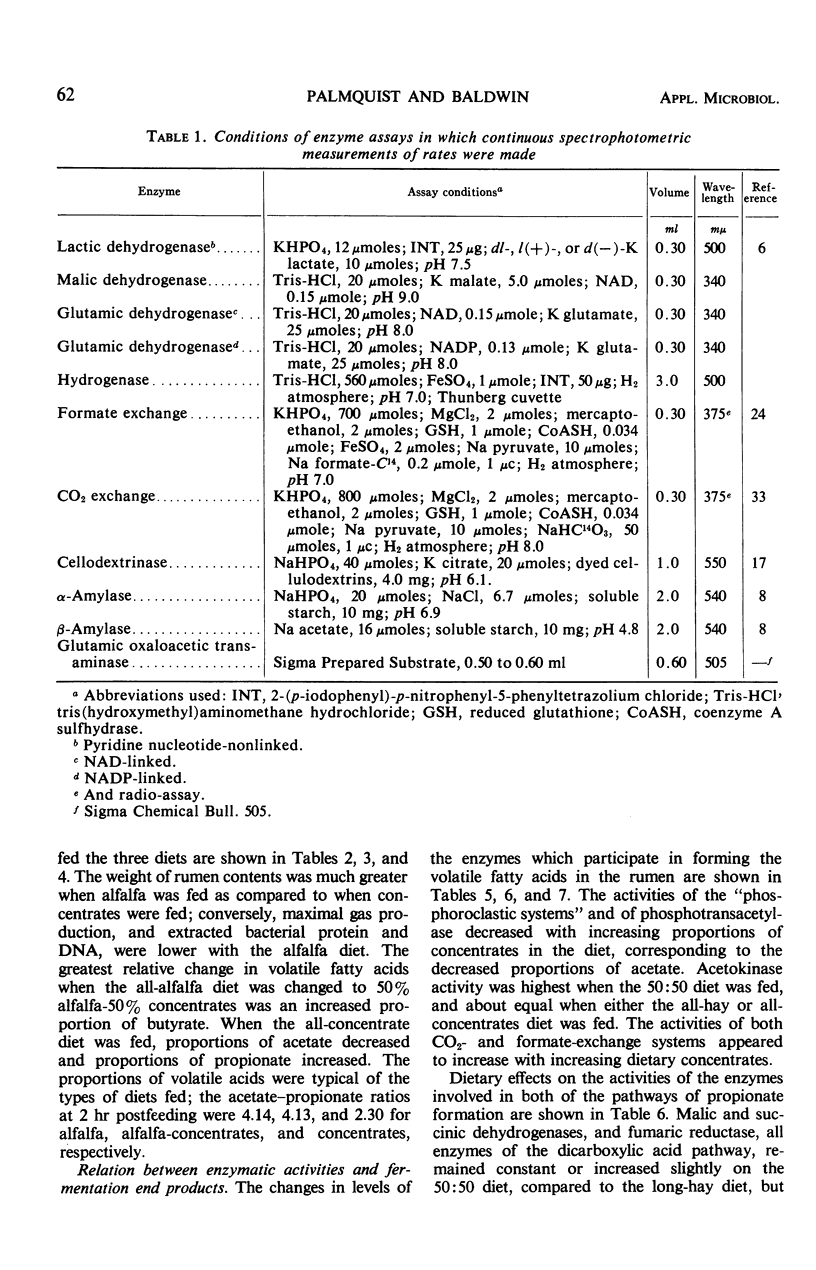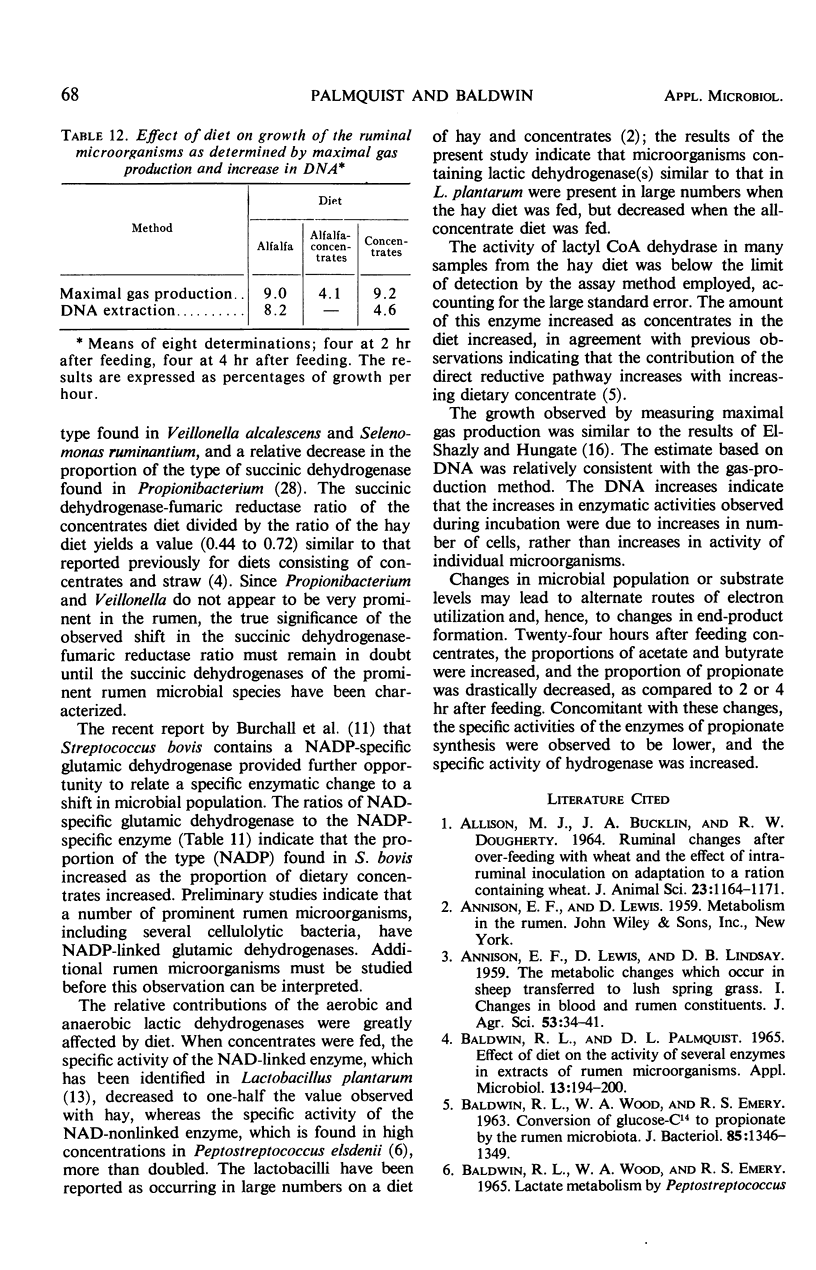Abstract
Enzymatic techniques were used to study the metabolism of carbohydrates by ruminal bacteria. A direct relationship was observed between the proportions of acetate and propionate formed and the specific activities of the enzymes which participate in forming these acids. An inverse relationship between butyrate formation and butyrate-forming enzymes was observed. The relative activities of succinic dehydrogenase to fumaric reductase, nicotinamide adenine dinucleotide-linked glutamic dehydrogenase to nicotinamide adenine dinucleotide phosphate-linked glutamic dehydrogenase, and pyridine nucleotide-nonlinked lactic dehydrogenase to pyridine nucleotide-linked lactic dehydrogenase were affected by the level of concentrates in the diet. Lactyl coenzyme A dehydrase activity was below the limits of the assay technique in many samples from the alfalfa hay diet, and increased to relatively high levels when concentrates were fed. It is suggested that the enzymatic method will prove valuable for studying the contributions of individual microorganisms to the overall ruminal metabolism, and, with certain limitations, useful for estimating the relative contributions of alternate pathways.
Full text
PDF









Selected References
These references are in PubMed. This may not be the complete list of references from this article.
- BALDWIN R. L., PALMQUIST D. L. EFFECT OF DIET ON THE ACTIVITY OF SEVERAL ENZYMES IN EXTRACTS OF RUMEN MICROORGANISMS. Appl Microbiol. 1965 Mar;13:194–200. doi: 10.1128/am.13.2.194-200.1965. [DOI] [PMC free article] [PubMed] [Google Scholar]
- BALDWIN R. L., WOOD W. A., EMERY R. S. CONVERSION OF GLUCOSE-C14 TO PROPIONATE BY THE RUMEN MICROBIOTA. J Bacteriol. 1963 Jun;85:1346–1349. doi: 10.1128/jb.85.6.1346-1349.1963. [DOI] [PMC free article] [PubMed] [Google Scholar]
- BLACKBURN T. H., HUNGATE R. E. Succinic acid turnover and propionate production in the bovine rumen. Appl Microbiol. 1963 Mar;11:132–135. doi: 10.1128/am.11.2.132-135.1963. [DOI] [PMC free article] [PubMed] [Google Scholar]
- BRYANT M. P. Bacterial species of the rumen. Bacteriol Rev. 1959 Sep;23(3):125–153. doi: 10.1128/br.23.3.125-153.1959. [DOI] [PMC free article] [PubMed] [Google Scholar]
- BURCHALL J. J., NIEDERMAN R. A., WOLIN M. J. AMINO GROUP FORMATION AND GLUTAMATE SYNTHESIS IN STREPTOCOCCUS BOVIS. J Bacteriol. 1964 Oct;88:1038–1044. doi: 10.1128/jb.88.4.1038-1044.1964. [DOI] [PMC free article] [PubMed] [Google Scholar]
- BURTON K. A study of the conditions and mechanism of the diphenylamine reaction for the colorimetric estimation of deoxyribonucleic acid. Biochem J. 1956 Feb;62(2):315–323. doi: 10.1042/bj0620315. [DOI] [PMC free article] [PubMed] [Google Scholar]
- DENNIS D., KAPLAN N. O. D- and L-lactic acid dehydrogenases in Lactobacillus plantarum. J Biol Chem. 1960 Mar;235:810–818. [PubMed] [Google Scholar]
- EL-SHAZLY K., HUNGATE R. E. FERMENTATION CAPACITY AS A MEASURE OF NET GROWTH OF RUMEN MICROORGANISMS. Appl Microbiol. 1965 Jan;13:62–69. doi: 10.1128/am.13.1.62-69.1965. [DOI] [PMC free article] [PubMed] [Google Scholar]
- FERNLEY H. N. The use of reactive dyestuffs in enzymology: new substrates for cellulolytic enzymes. Biochem J. 1963 Apr;87:90–95. doi: 10.1042/bj0870090. [DOI] [PMC free article] [PubMed] [Google Scholar]
- HUNGATE R. E. Microorganisms in the rumen of cattle fed a constant ration. Can J Microbiol. 1957 Mar;3(2):289–311. doi: 10.1139/m57-034. [DOI] [PubMed] [Google Scholar]
- HUNGATE R. E. Symposium: selected topics in microbial ecology. I. Microbial ecology of the rumen. Bacteriol Rev. 1960 Dec;24(4):353–364. doi: 10.1128/br.24.4.353-364.1960. [DOI] [PMC free article] [PubMed] [Google Scholar]
- JAYASURIYA G. C., HUNGATE R. E. Lactate conversions in the bovine rumen. Arch Biochem Biophys. 1959 Jun;82(2):274–287. doi: 10.1016/0003-9861(59)90123-7. [DOI] [PubMed] [Google Scholar]
- LOWRY O. H., ROSEBROUGH N. J., FARR A. L., RANDALL R. J. Protein measurement with the Folin phenol reagent. J Biol Chem. 1951 Nov;193(1):265–275. [PubMed] [Google Scholar]
- McCormick N. G., Ordal E. J., Whiteley H. R. DEGRADATION OF PYRUVATE BY MICROCOCCUS LACTILYTICUS I. : General Properties of the Formate-Exchange Reaction. J Bacteriol. 1962 Apr;83(4):887–898. doi: 10.1128/jb.83.4.887-898.1962. [DOI] [PMC free article] [PubMed] [Google Scholar]
- SIJPESTEIJN A. K., ELSDEN S. R. The metabolism of succinic acid in the rumen of the sheep. Biochem J. 1952 Sep;52(1):41–45. doi: 10.1042/bj0520041. [DOI] [PMC free article] [PubMed] [Google Scholar]
- WARNER A. C. Enumeration of rumen micro-organisms. J Gen Microbiol. 1962 Apr;28:119–128. doi: 10.1099/00221287-28-1-119. [DOI] [PubMed] [Google Scholar]
- WARNER A. C. Some factors influencing the rumen microbial population. J Gen Microbiol. 1962 Apr;28:129–146. doi: 10.1099/00221287-28-1-129. [DOI] [PubMed] [Google Scholar]
- WHITELEY H. R., McCORMICK N. G. Degradation of pyruvate by Micrococcus lactilyticus. III. Properties and cofactor requirements of the carbon dioxide-exchange reaction. J Bacteriol. 1963 Feb;85:382–393. doi: 10.1128/jb.85.2.382-393.1963. [DOI] [PMC free article] [PubMed] [Google Scholar]


